Introduction
Tour
{{section_header}}{{section.name}}{{/section_header}}




Ease of Use
{{section_header}}{{section.name}}{{/section_header}}
Casio did not have a working model of the Tryx available at CES, so we can't say much about how easy the camera is to use. We will say that the many ways you can twist and turn the Tryx will definitely have an impact on its ease of use. There's a solution for virtually every handling situation, including a handy tripod setup and hanging setup that should make self-portraiture even easier.
The camera body has very few buttons, indicating that most functions will be controlled with the 3.0-inch LCD touchscreen. To help make the Tryx even easier to use, Casio is loading it up with some social media-friendly software. This is all about making it easy to upload your photos and videos to Facebook, Flickr, and YouTube.
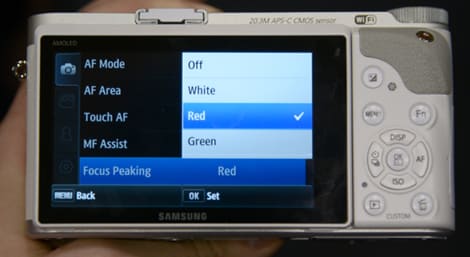

Size & Handling
{{section_header}}{{section.name}}{{/section_header}}
The Tryx is a thin camera, though not small. Its dimensions measure 4.83” x 2.32” x 0.59” and it weighs just 5.54 oz. Those dimensions make the Tryx a little larger than the slimmest ultracompact cameras, but still small enough and slender enough to fit easily inside a pocket. What’s most reassuring is that the Tryx feels like a very substantial piece of electronics, despite its plethora of moving parts. This feels like a camera that you can toss in your bag or pocket without concern for the Tryx’s well-being.
Of course, size isn’t really the story with Tryx. The story is the camera’s eccentric design, which encourages users to twist and turn the camera for all sorts of unique configurations. The frame can rotate 360° and the LCD can rotate up to 270°. That means that you can get the tripod shape above and the varieties you see below. Of course, Casio suggests that you hang the Tryx on a doorknob or hook, but we think it works just as well as a fancy necklace.
In its ordinary point-and-shoot camera configuration, the Tryx feels perfectly fine. It’s comfortable to hold, though there isn’t much to encourage a solid grip. If you’re shooting video, you might want to try out the camcorder orientation, which isn’t quite as nice as a real camcorder, but we found that it works pretty well.
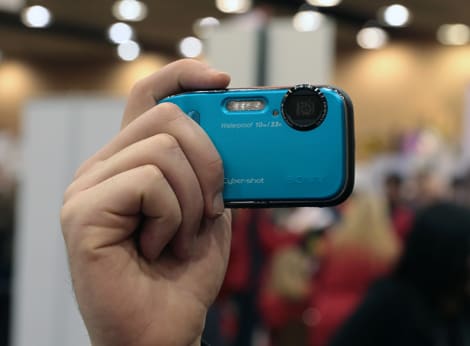
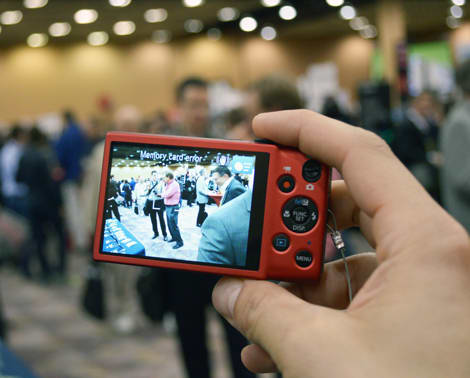
Manual Controls
{{section_header}}{{section.name}}{{/section_header}}
Though we didn't have a working model to try out the camera's manual controls, we did get a sense that the Tryx does not have a number of options for consumers looking for flexibility. What minor controls you do get are selected via the LCD touchscreen and/or the small selector bar on the side of the LCD.

Focus
{{section_header}}{{section.name}}{{/section_header}}
The Tryx has a fixed lens with a focal length of 3.8mm (35mm equivalent of 21mm). The contrast detection auto focus can be set to one of three modes: auto, macro, and infinity. According to the specs, Autofocus has a range of 3.0 inches to infinity, while Macro limits the range to 3.0 to 20.0 inches. It seems as though the Tryx can only be set to spot autofocus.
It looks like there's an autofocus assist lamp on the front of the lens, but the specs state that there is no AF assist.
ISO
{{section_header}}{{section.name}}{{/section_header}}
ISO can be set in still mode only, with a modest selection of Auto, 100, 200, 400, 800, 1600, and 3200.
Aperture & Shutter Speed
{{section_header}}{{section.name}}{{/section_header}}
Aperture and shutter speed are handled entirely automatically on the Tryx. Aperture is, of course, fixed at F2.8, while shutter speed has a fairly wide range. The specs state that range as 1/8-1/40000, but it's more likely that the fastest shutter speed is 1/4000.
White Balance
{{section_header}}{{section.name}}{{/section_header}}
White balance can be left to automatic adjustment, can be calibrated manually, or can be set to one of these options: Daylight, Overcast, Shade, Day White Fluorescent, Daylight Fluorescent, or Tungsten.
Exposure & Metering
{{section_header}}{{section.name}}{{/section_header}}
Without access to shutter speed or aperture, exposure may be your go-to method of adjusting brightness. You have the usual option of tweaking exposure from -2 to +2 in 1/3 EV steps.
Picture Quality & Size Options
{{section_header}}{{section.name}}{{/section_header}}
The Tryx has a fair number of image size options, ranging from 12MP to a small 640 x 480 VGA photo size. All photos are recorded as JPEGs. The camera also has a movie mode, which records 1080/30p HD video, with additional options for 720/30p and slow-motion recording at 240fps. Video is recorded in the .mov format, encoded in H.264/AVC with monaural audio.
Picture Effects
{{section_header}}{{section.name}}{{/section_header}}
Casio would like you to think that the star of their show is this HDR-ART feature. According to Casio:
"Tryx also incorporates Casio’s revolutionary HDR-ART technology, which gives users the ability to effortlessly transform any photo from ordinary to extraordinary, all with just the touch of a button. HDR-ART works by combining continuous shots with differing exposures and performing highly-precise image analysis to locally change the contrast and level of color saturation. Users can select from three different processing levels to suit their artistic tastes and produce results that are guaranteed to impress."
HDR-ART is plastered all over the Casio booth at CES and, frankly, there was no point at which we were impressed.
LCD
{{section_header}}{{section.name}}{{/section_header}}
The Casio Tryx has a sexy 3.0-inch TFT color LCD touchscreen with 460,800-dot resolution. Of course, the LCD can be rotated around for easy self-portraiture or a clever camcorder-like configuration. The touchscreen provides users with all sorts of bonus features, including touch-shutter and touch-activated self-timer. That self-timer can be set to auto-activate when the motion sensor detects motion within a designated area of the frame. We didn't get a chance to test out this feature, but it certainly sounds neat in theory.

Flash
{{section_header}}{{section.name}}{{/section_header}}
The Tryx does not appear to have a flash—a strange omission that may turn away some users.

Lens & Sensor
{{section_header}}{{section.name}}{{/section_header}}
Casio has crammed a 21mm wide angle lens into the Tryx, hoping that the wide angle will make it easier for people to shoot self-portrait groups shots and more. The lens also has Casio's "state-of-the-art" High-Speed SR Zoom technology. This tech lets you get a 1.5x or 2.0x zoom out of the fixed lens by decreasing the resolution of the photos taken.
There's a nifty little sensor inside the Tryx: a 1/2.3-inch back-illuminated CMOS. The gross pixel count is 12.75MP, while the effective pixel count is 12.1 megapixels.

Jacks, Ports & Plugs
{{section_header}}{{section.name}}{{/section_header}}
You can transfer files on the Tryx by using either the removable memory cards or connecting via USB. There's also an HDMI port for connecting the camera directly to your HDTV.
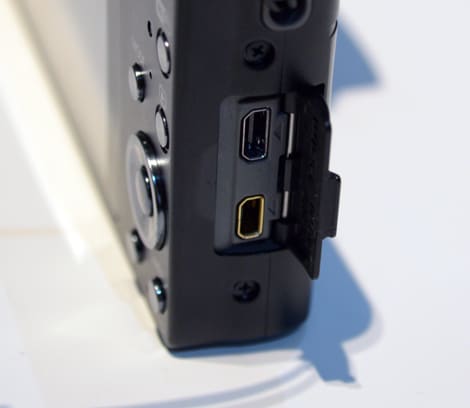
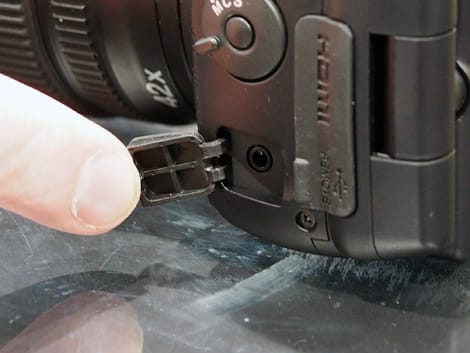
Battery
{{section_header}}{{section.name}}{{/section_header}}
The Tryx has a built-in rechargeable lithium ion battery. It looks like the camera ships with a USB AC adapter, but we're guessing you can also charge the Tryx directly via USB.

Memory
{{section_header}}{{section.name}}{{/section_header}}
All photos and video are recording to removable SD/SDHC/SDXC memory cards.
{{product.manufacturer_specs['FI Memory Photo']}}
Conclusion
The Casio Tryx is certainly a unique twist on the compact point-and-shoot category. You can fashion it into a picture frame, a necklace, or... you know, a camera. The Tryx takes 12-megapixel photos and 1080/30p video, but the star is its rotating LCD touchscreen and unique frame design. Some people might look at the Tryx and think it's the wave of the future. Others might think it's just a bizarre wannabe fad. Like it or not, the Tryx will hit store shelves in April for $249.99. We'll try to get our paws on a fully functional model so we can test it out before then.
Sample Photos
{{section_header}}{{section.name}}{{/section_header}}
Specs
{{manufacturer_specs_table}}
Meet the tester
Vice President of Editorial Management, Kaitlyn oversees the editorial departments of Reviewed.com’s various sites. She has been writing about technology since the turn of the century. Outside of her Reviewed.com home, Kaitlyn is also a theatre director and avid gamer.
Checking our work.
Our team is here to help you buy the best stuff and love what you own. Our writers, editors, and experts obsess over the products we cover to make sure you're confident and satisfied. Have a different opinion about something we recommend? Email us and we'll compare notes.
Shoot us an email